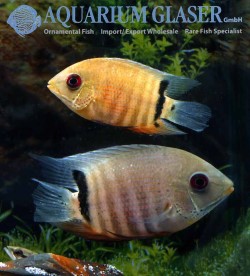|
Affiliate Disclaimer : We
work to provide tropical fish information and locate merchants who sell the products
you are looking for. If you make a purchase from any of the merchants we endorse, we
will earn a small commission at no additional cost to you. Thank you for your support!
Home > Heros liberifer a new species mouthbrooding Heros cichlid

Heros liberifer a new species mouthbrooding Heros cichlid


The mouthbrooding Heros from Venezuela: a new species!
At least from 1992 on Heros have been exported from Venezuela that were thought - according to scientific and hobby publications - to belong to the species Heros severus Heckel, 1840. In 1994 the aquarium community learned fascinated the fact that these "real" H. severus (all other Heros in the hobby belong to different species of Heros) are larvophilous mouthbrooders.
Recent collections from travelling aquarists in Venezuela showed that actually two different species of Heros live syntopically in Venezuela, namely the "mouthbrooder" and another species (Peter Dittrich, DCG-Info 2014: 21-24). This inspired Wolfgang Staeck and Ingo Schindler to re-examine the holotype of Heros severus once more. They found that the mouthbrooder in fact represents an undescribed species which they named Heros liberifer; the specific name means "carrier of children" in reference to the larvophilous mouthbrooding behaviour which is unique in the genus.
From all other (described) species of Heros H. liberifer can be distinguished by the pattern: parallel rows of red spots on the lower part of the body; a clearly visible caudal spot in adult specimens (in all other species of Heros the caudal spot merges with the vertical dark bar on the caudal peduncle in adults), and small dark spots on cheek and operculum in males (vs. large dark spots or a worm-like pattern). H. liberifer is distinguished furthermore from the at least sometimes syntopical H. severus by following features: iris of the eye bright red (vs. brown or dark red in H. severus), several anatomical details which are not recognizable in living animals, and the fact that the vertical dark bar number four (counted from the tail to the head) is shortened in H. severus and runs only to the lateral line of the body, while in H. liberifer this bar runs from the basis of the anal fin to the basis of the dorsal fin. The "really real" H. severus was named in the hobby so far most often H. sp. "Inirida". Sadly the very easy-to-see feature - the shortened dark vertical bar 4 - is reliable in wild collected specimens only. In bred ones obviously unwanted hybridisations appeared sometimes, because in these fish sometimes a great variation of this feature is observable.
However, in all specimens studied for the description of H. liberifer the feature of vertical bar 4 seems to be quite reliable, despite the fact that Schindler (in DCG-Info 2015: 117) already stated that rarely exceptions appear. So it is a very unexpected coincidence that among the animals we photographed for determination purposes immediately after their arrival in our fishhouse in June this year was one specimen that had the bar-four-pattern of H. severus, but the coloration of H. liberifer! Sadly we cannot say if the shortened bar 4 appeared on both sides of the body and the animal is sold already. However, the species-specific coloration (eye, red dots etc.) of the specimen fits perfectly for H. liberifer.
All Heros liberifer we currently have in stock show the species-specific pattern in a perfect way. This is a good opportunity to provide oneself with wild collected specimens of this very beautiful, mouthbrooding species!
For our customers: the fish have code 682944 on our stock list. Please note that we exclusively supply the wholesale trade.
Literature: Staeck, W. & I. Schindler (2015): Description of a new Heros species (Teleostei, Cichlidae) from the Rio Orinoco drainage and notes on Heros severus Heckel, 1840. Bulletin of Fish Biology 15 (1/2): 121-136

Heros liberifer photos
References
|


